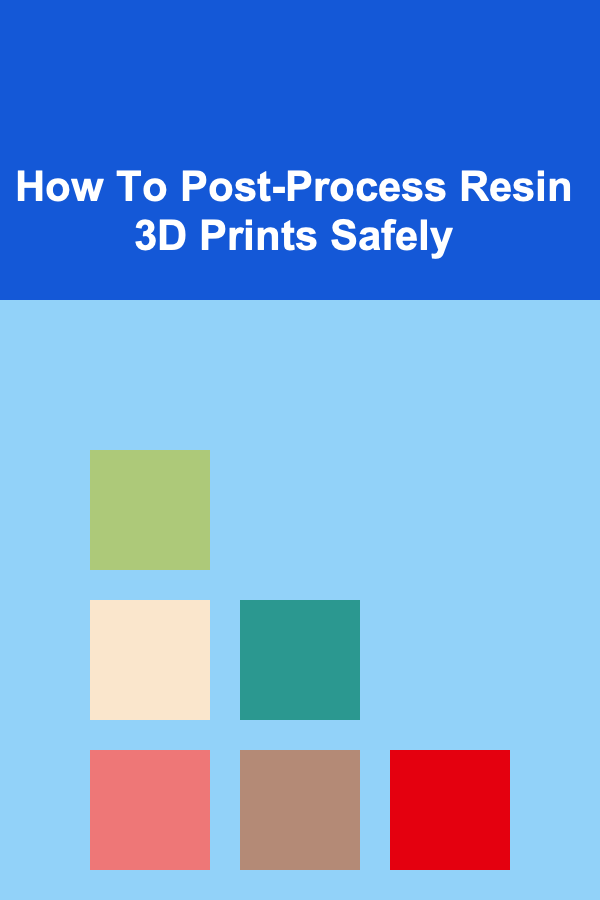
How To Post-Process Resin 3D Prints Safely
ebook include PDF & Audio bundle (Micro Guide)
$12.99$8.99
Limited Time Offer! Order within the next:

Resin 3D printing has revolutionized the world of additive manufacturing, providing high-resolution prints and the ability to produce intricate, detailed objects. However, resin printing also comes with certain challenges and safety considerations, particularly during the post-processing phase. Post-processing is a crucial step in turning a raw resin print into a finished, usable object. It involves several steps such as washing, curing, and sometimes sanding or painting the model.
This article will provide an in-depth guide on how to safely post-process resin 3D prints. We will walk through the necessary steps, the tools and equipment you'll need, and most importantly, the safety protocols that should be followed to ensure that the post-processing process is carried out safely and effectively.
Understanding Resin Printing and Its Post-Processing Needs
Before diving into the post-processing steps, it's essential to understand why resin 3D prints require specific post-processing. Unlike filament-based FDM printing, which builds layers of material on top of each other, resin printing uses a liquid photopolymer resin that hardens when exposed to UV light. The print is completed by curing layer by layer, which means that after the printing process is done, the object is often still covered with uncured resin and may have support structures in place that need to be removed.
Additionally, many resins are not fully solidified after printing and require additional curing to reach their final strength and stability. Post-processing resin prints ensures that the object not only looks better but also functions as intended, with smooth surfaces, full curing, and removal of unwanted elements like support material.
Safety Precautions When Handling Resin Prints
Resin is often toxic, and while many resins are formulated to be safer than others, they can still pose health risks if proper precautions are not taken. It's essential to prioritize safety throughout the post-processing workflow. Here are some of the key safety guidelines to follow:
1. Wear Protective Gear
The first rule in resin post-processing is to wear protective gear. This includes:
- Gloves: Always wear nitrile gloves (not latex) when handling uncured resin. Resin can irritate the skin, and prolonged exposure can cause more severe health problems.
- Eye Protection: While working with resin and its fumes, it's crucial to wear protective eyewear to avoid any resin splashes getting into your eyes.
- Respirator Mask: Many resins emit harmful vapors, especially during the curing process. Wearing an N95 respirator or other mask designed for chemical fumes will help protect you from inhaling hazardous particles.
- Apron or Lab Coat: To further prevent direct skin contact, wear an apron or a lab coat while post-processing your resin prints.
2. Ensure Proper Ventilation
Resin prints and the materials used for post-processing can release harmful volatile organic compounds (VOCs) during washing or curing. Therefore, ensure that your workspace is well-ventilated to prevent the buildup of fumes. Ideally, you should perform the post-processing in a room with good airflow, or better yet, work outdoors or in an area equipped with a fume extractor.
3. Avoid Direct Contact with Cured Resin
Cured resin is less toxic than uncured resin but should still be handled with care. After the print has been fully cured, it is best to avoid excessive contact with the material, especially with heat or direct sunlight, which can cause it to release hazardous compounds.
Step-by-Step Guide to Post-Processing Resin 3D Prints
Step 1: Removing the Print from the Build Plate
The first step after your print finishes is to carefully remove the model from the build plate. Resin prints are typically adhered strongly to the plate, and trying to force them off can result in breakage. Here's how to safely remove the print:
- Prepare the Work Area: Make sure your work area is clean and well-ventilated, and ensure you're wearing gloves and protective eyewear.
- Use the Appropriate Tools: A plastic scraper or spatula is the best tool to use for removing prints from the build plate. Metal tools can scratch the build surface or damage the print.
- Apply Gentle Pressure: Carefully work the tool under the print, gradually lifting it off the build plate. If the print doesn't come off easily, try slightly bending the build plate or using a gentle back-and-forth motion.
Step 2: Washing the Print
Once the print is removed from the build plate, it's essential to clean off any excess uncured resin. This is usually done with a wash station or by submerging the print in isopropyl alcohol (IPA) or another resin-safe cleaning solution. The washing process is vital to ensure that no uncured resin is left on the surface, as it can cause distortion, tackiness, or other issues.
Steps for Washing the Print:
- Choose the Right Cleaning Solution: Isopropyl alcohol (IPA) is a popular choice for cleaning resin prints. Some people use higher concentrations (90% or above) for better results. Alternatively, you can use a dedicated resin cleaner, which may offer more efficient cleaning without being as harsh on the print.
- Submerge the Print: Place the print into the IPA solution, ensuring the entire model is submerged. Use a container that is large enough to allow the print to be fully submerged without spilling the solution.
- Agitate the Print: Gently agitate the print in the alcohol, swirling it around to dislodge any excess resin. Some washing stations come with a built-in agitator, which can make this process easier.
- Rinse with Clean IPA: After cleaning the print in the initial bath, transfer it to a second container with clean IPA and repeat the rinsing process. This ensures that any remaining uncured resin is thoroughly cleaned off.
Step 3: Drying the Print
After washing, it's essential to remove all traces of alcohol from the print. To do this safely:
- Shake Off Excess Liquid: Gently shake the print to remove any excess IPA or cleaner.
- Use a Dry Cloth or Paper Towel: Pat the print dry with a lint-free cloth or paper towel. Be gentle, as resin prints can be fragile before fully curing.
- Allow the Print to Air Dry: Place the print in a safe, clean area to air dry completely. It's important to ensure that all the cleaning solution has evaporated before moving on to the curing stage.
Step 4: Curing the Print
Curing is the process of exposing the print to UV light to harden and stabilize the resin. While some resins are semi-cured right after printing, a full post-cure is necessary to achieve the desired durability and surface finish.
Curing Process:
- Use a UV Curing Station: The most efficient way to cure resin prints is by using a UV curing station, which has built-in UV lights to cure the print evenly. These stations often come with a rotating turntable to ensure the print gets uniformly exposed to UV light.
- Cure Under Direct Sunlight: If you don't have a dedicated curing station, you can place the print outside in direct sunlight for a few hours, although this method is less controlled and may take longer.
- Time and Exposure: The time required for curing will vary depending on the resin type and print size. A typical curing time in a UV station is between 5 and 15 minutes. Make sure to check the manufacturer's recommendations for curing time.
Step 5: Post-Curing Inspection
Once the print has been fully cured, inspect it for any imperfections, excess resin, or areas that may need additional post-processing. Common areas to check include the surfaces where supports were attached, as these can sometimes be rough or uneven.
Step 6: Sanding and Finishing
Many resin prints require additional post-processing to achieve a smooth surface or to remove any support marks. Here's how to safely finish the print:
- Sanding: If your print has rough areas or visible support marks, you can use sandpaper to smooth it out. Start with a lower grit (around 200) and gradually move to higher grits (up to 1000) for a smoother finish. Always sand gently, as resin prints can break if too much force is applied.
- Filling Gaps: If there are small gaps or holes in the print, consider using a resin filler or epoxy to fill them. Once the filler is applied, let it cure before sanding for a smooth finish.
- Painting: If you plan to paint your resin print, ensure it's thoroughly cleaned and cured. Use paints that are appropriate for resin surfaces, such as acrylic paints. A primer coat can be helpful before applying colored layers.
Step 7: Final Inspection and Touch-ups
After sanding and painting, do a final inspection of the print for any missed spots or imperfections. This is your chance to touch up the model and make any adjustments before it's ready for use.
Conclusion
Post-processing resin 3D prints is a crucial step in transforming raw prints into functional and visually appealing objects. While the process can be time-consuming, following the appropriate steps and safety protocols ensures that you achieve the best results while minimizing health risks. By wearing the right protective gear, working in a well-ventilated area, and following the post-processing steps carefully, you can safely and effectively turn your resin prints into finished pieces that meet your expectations for quality and durability.

How to Use Color Schemes to Enhance Your Holiday Decorations
Read More
How to Pair Wine with Seafood
Read More
Understanding the Legal Aspects of Virtual Reality
Read More
Potty Training Power: A Stress-Free Approach
Read More
Building a Relationship That Lasts a Lifetime
Read More
10 Tips for Building Trust in Your Community as a Police Officer
Read MoreOther Products

How to Use Color Schemes to Enhance Your Holiday Decorations
Read More
How to Pair Wine with Seafood
Read More
Understanding the Legal Aspects of Virtual Reality
Read More
Potty Training Power: A Stress-Free Approach
Read More
Building a Relationship That Lasts a Lifetime
Read More